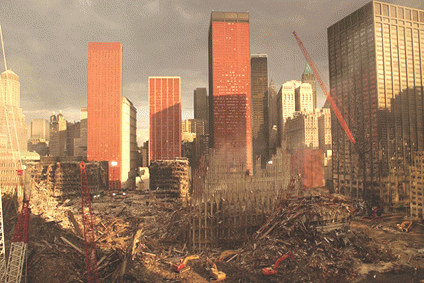
Ground Zero World Trade Center
(Image by FEMA - 4235 - Photograph by Andrea Booher taken on 09-28-2001 in New YorkP) Details DMCA
The Power of Nightmares Part 3 by Adam Curtis - "The Shadows in the Cave"
"The final episode addresses the actual rise of al-Qaeda. Curtis argues that, after their failed revolutions, bin Laden and Zawahiri had little or no popular support, let alone a serious complex organisation of terrorist............After the American invasion of Afghanistan fails to uproot the alleged terrorist network, the Neo-Conservatives focus inwards, searching unsuccessfully for terrorist sleeper cells in America. They then extend the war on "terror" to a war against general perceived evils with the invasion of Iraq in 2003."
Critiques of The Power of Nightmares - Wikipedia, the free encyclopedia bit.ly/1p8QY17
Summary of Power of Nightmares - "The Shadows in the Cave"
By Pal Simon
This section repeats much of what is shown in Parts 1 and 2, and generally the newest observations are as follows:
In 2001 in Federal Court in New York Americans were prosecuting the four bombers on charges related to the simultaneous bombings at two American embassies in Kenya and Tanzania on August 7, 1998 which killed 224 people and wounded thousands. Prosecutors wanted to be able to establish the existence of a large organization of terror so that any of their leaders could be tried in absentia for the crimes of the member followers, (as was the law of case for Mafia prosecutions.) But bin-Laden had no large "criminal organization so they invented one for him. They got help for this from Jamal Ahmed Al-Fadl who was to become a witness in the case.
In an interview on this video, Jason Burke (See note 1) said of Jamal Ahmed Al-Fadl that he was a Sudanese ex-militant who had no credibility but was taken up by the prosecutors as a key prosecution witness and given a great deal of taxpayer money.
He said they got al-Fadl and a number of other witnesses that were willing to make a case from "raw material" and to turn this into testimony that would fit the needs which the prosecutors told them they required. This turns into an extremely influential "first al-Qaeda myth." Curtis said that "In fact, Jamal Ahmed Al-Fadl, having stolen money from bin-Laden, was actually on the run. In return for his evidence Americans gave him witness protection and hundreds of thousands of dollars."
The Defense lawyer Sam Schmidt stated in interview that he believed Al-Fadl fabricated much of his testimony to meet the needs of prosecutors.
Curtis said the evidence produced by prosecutors painted a mythical picture of a huge organized terror network under bin-Laden, who had also given this network the name "al-Qaeda." But the reality was that al-Qaeda was not a huge organization, only a "loose association of dissident groups who planned their own operations and looked to bin-Laden for funding. He was not their commander. There was also no evidence that bin-Laden had ever used the term al-Qaeda until after September 11th, when he realized this was the term Americans had given them." And Brock in interview agreed and reiterated that there is no such organization called al-Qaeda with sleeper cells all over the world that obeys commands from a central figure or organization, spreading its tentacles out.... this "simply does not exist." And yet, now having al-Queda recognized as a world wide criminal organization, the government could prosecute any members and commanders of such an organization anywhere around the world in the same way they could legally do so for a mafia member. (See Notes 2 and 3.)
(Note: You can view every article as one long page if you sign up as an Advocate Member, or higher).





